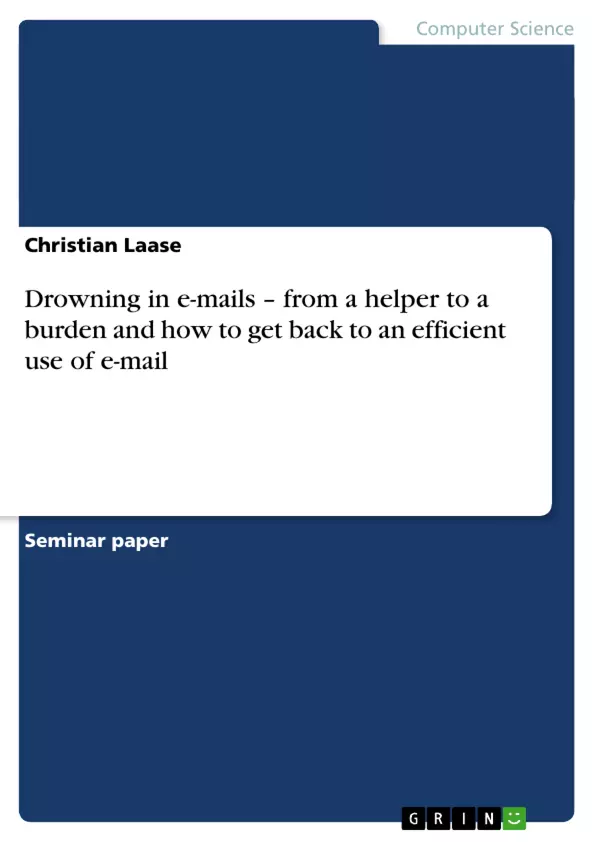1. Introduction
The significance of email as a modern medium for communication has grown fast and sustainable. The technical basis, especially the availability of a digital infrastructure enabled the global spread of email as a user friendly, flexible and versatile medium. By now email can be considered as one of the most frequently used applications of the internet. The advantages of email as being low in costs but high in speed and reliability led to its increasing use and significance. Furthermore its quality of being “viral” through easy forwarding and multi-receiver-sending has opened new possibilities for communication. On the one hand the disposability of email has led to these new trends, on the other hand the very same quality can be held responsible for the short-lived and unsustainable attributes of email.1
Since the emergence of the first communication through electronic mail the face of email concerning both quality and quantity has changed significantly. In terms of quality it has changed from a simple substitute for the hand written letter to today’s most important tool for collaboration, knowledge-management, online marketing and global business communication. Furthermore it is “now used for multiple purposes: document delivery and archiving, work task delegation; and task tracking. It is also used for storing personal names and addresses, for sending reminders, asking for assistance, scheduling appointments, and for handling technical queries.” Electronic mail can be considered as vital precursor for globalization and the modern information society. Its commercial use for offers, contracts, orders etc. created demand for an obliging and explicit legal framework together with new standards regarding electronic signature, identification and data safety.
The trend of an increasing quantity of electronic mail is strongly related to its development, standardization and availability of digital infrastructure. The exponentially increasing amount of email per day has led to serious problems regarding efficiency in the use of the medium and to new challenges both for the technical infrastructure, the software and the user.
Inhaltsverzeichnis (Table of Contents)
- Introduction
- Problems resulting from increasing Email Traffic
- Technical Problems
- Economical Problems
- Personal Problems
- Personal and Business related Email
- Email Lifecycle Management
- ELM Process
- Unsolicited commercial Messages: SPAM
- Spam Filter
- Classical Filter Methods
- New Approaches for encountering spam
- Legislation
- Spam Filter
- Concluding Remarks
Zielsetzung und Themenschwerpunkte (Objectives and Key Themes)
This paper aims to examine the negative impacts of increasing email traffic on the efficient use of email, exploring strategies for regaining a positive and efficient email experience for both personal and business communication. The paper provides a comprehensive overview of the challenges arising from email overload, the different components of increasing email traffic, and potential solutions to address these issues.
- The impact of increasing email traffic on efficiency
- Strategies for managing and mitigating email overload
- The role of email lifecycle management in controlling email traffic
- The problem of unsolicited commercial messages (spam)
- Techniques for combating spam and its impact on email communication
Zusammenfassung der Kapitel (Chapter Summaries)
The paper begins by highlighting the significance of email as a communication tool, its evolution, and the challenges posed by increasing email volume. Chapter two focuses on the various problems arising from email overload, addressing technical, economic, and personal difficulties. Chapter three explores the management of personal and business-related email, introducing the concept of email lifecycle management and its processes. Chapter four delves into the issue of spam, examining different spam filter methods, including classical and new approaches, as well as relevant legal frameworks. Finally, the paper offers concluding remarks on the importance of addressing email overload and its implications.
Schlüsselwörter (Keywords)
The paper focuses on the key concepts of email overload, email lifecycle management, spam filtering, and legal frameworks concerning electronic communication. It explores the implications of increasing email traffic for efficiency, user experience, and the overall effectiveness of email communication.
- Quote paper
- Dipl.-Kfm. Christian Laase (Author), 2005, Drowning in e-mails – from a helper to a burden and how to get back to an efficient use of e-mail, Munich, GRIN Verlag, https://www.grin.com/document/73979



